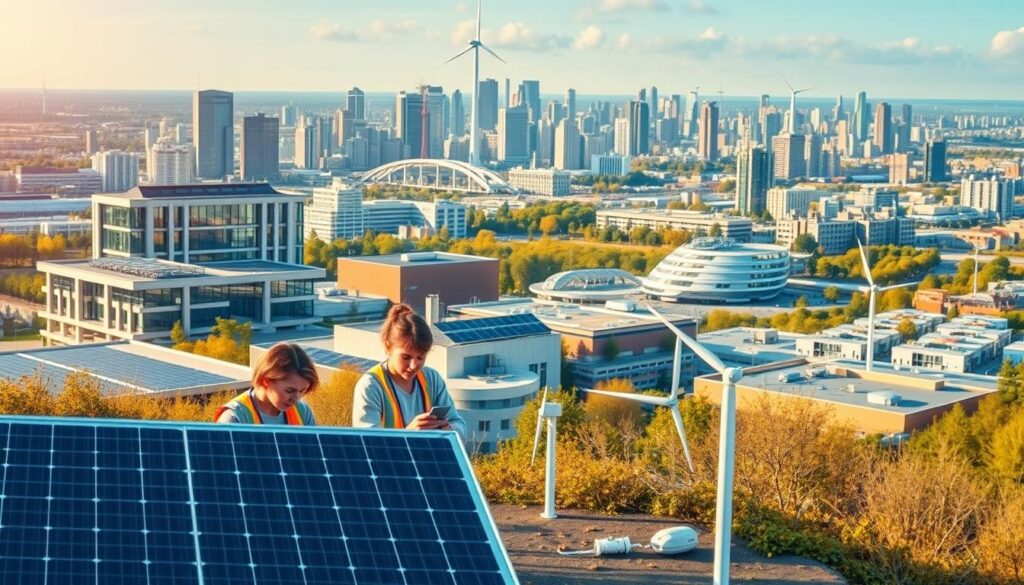The world is shifting towards renewable energy integration at an unprecedented rate, driven by the urgent need to combat climate change and deplete fossil fuel reserves. As a crucial sector in infrastructure development, civil engineering plays a vital role in this transition.
Civil engineers are now tasked with designing and building sustainable infrastructure that not only supports the existing energy grid but also accelerates the adoption of renewable energy sources. This involves innovative approaches to infrastructure development, ensuring that it is environmentally friendly, economically viable, and socially responsible.
Key Takeaways
- The global transition to renewable energy is driving the need for sustainable infrastructure.
- Civil engineering plays a crucial role in promoting renewable energy integration.
- Sustainable infrastructure development is key to a low-carbon future.
- Innovative infrastructure design is necessary to support renewable energy adoption.
- Civil engineers must balance environmental, economic, and social considerations.
The Importance of Sustainable Infrastructure in Civil Engineering
Civil engineering is evolving with a significant emphasis on sustainable infrastructure to meet today’s needs without compromising the future. This shift is crucial as the world grapples with environmental challenges, and infrastructure development plays a pivotal role in mitigating these issues.
Understanding Sustainability Principles
Sustainability principles in civil engineering focus on minimizing environmental impacts, enhancing resource efficiency, and building resilience against climatic events. Green engineering solutions are integral to this approach, incorporating innovative designs and materials that reduce ecological footprints.
For a deeper dive into the future of sustainable infrastructure, visit this insightful article that explores the evolving landscape of civil engineering.
Benefits of Sustainable Infrastructure
The benefits of sustainable infrastructure are multifaceted, including reduced energy consumption, lower operational costs, and enhanced public health. By adopting sustainable practices, civil engineers can significantly contribute to environmental stewardship.
| Benefits | Description | Impact |
|---|---|---|
| Reduced Energy Consumption | Efficient designs and renewable energy integration | Lower carbon footprint |
| Lower Operational Costs | Sustainable materials and energy-efficient systems | Cost savings over time |
| Enhanced Public Health | Improved air and water quality through green infrastructure | Better quality of life |
Role of Civil Engineers in Promoting Sustainability
Civil engineers play a pivotal role in promoting sustainability through their projects and practices. By embracing civil engineering sustainability, they can drive innovation and implement solutions that benefit both the environment and society.
Through their work, civil engineers can influence the adoption of green technologies and sustainable materials, thereby shaping the future of infrastructure development.
What is Renewable Energy?

Renewable energy sources are local, abundant, and can significantly reduce our reliance on imported fossil fuels. This shift towards renewable energy integration is crucial for creating sustainable infrastructure.
Renewable energy comes from natural sources that are replenished over time, unlike fossil fuels, which are finite. The most common types of renewable energy include solar energy, wind power, hydro power, and geothermal energy. These sources can be harnessed using various clean energy technologies to generate electricity or provide heating and cooling.
Overview of Renewable Energy Sources
There are several types of renewable energy sources that can be utilized in renewable energy projects. Solar energy harnesses the power of the sun’s rays, either through photovoltaic panels or solar thermal systems. Wind power generates electricity using wind turbines, while hydro power leverages the energy of moving water through dams or run-of-river systems. Geothermal energy taps into the heat from the Earth’s core, providing both heating and electricity generation.
For more information on integrating renewable energy into civil designs, you can read this insightful article on LinkedIn.
Key Facts about Renewable Energy in the U.S.
In the United States, renewable energy is becoming increasingly important as a component of the national energy mix. According to recent data, renewable energy accounts for a significant and growing portion of the country’s electricity generation. The U.S. is rich in renewable energy resources, with substantial potential for solar, wind, and geothermal energy.
The adoption of renewable energy in the U.S. is driven by various factors, including environmental concerns, energy security, and economic benefits. As clean energy technology continues to advance, the cost of renewable energy is decreasing, making it more competitive with traditional fossil fuels.
The Need for Renewable Energy in Civil Engineering
As the world grapples with climate change, the need for renewable energy in civil engineering has become more pressing than ever. Traditional construction methods have been notorious for their significant environmental impacts, from high energy consumption to the depletion of natural resources.
Environmental Impacts of Traditional Construction
Traditional construction practices are not only energy-intensive but also result in substantial greenhouse gas emissions. The production of construction materials like cement and steel is among the largest contributors to CO2 emissions. Furthermore, the extraction and processing of these materials can lead to habitat destruction and water pollution.
Key environmental impacts include:
- High energy consumption
- Greenhouse gas emissions
- Resource depletion
- Habitat destruction
Addressing Climate Change Through Infrastructure
Renewable energy can play a pivotal role in mitigating the environmental impacts of infrastructure development. By integrating sustainable energy solutions into civil engineering projects, we can significantly reduce the carbon footprint of construction activities. Eco-friendly infrastructure design and green building practices are crucial for creating sustainable infrastructure that not only supports economic growth but also protects the environment.
Some effective strategies for addressing climate change through infrastructure include:
- Incorporating renewable energy sources like solar and wind power into building designs
- Implementing energy-efficient systems and materials
- Designing infrastructure that is resilient to the impacts of climate change
By adopting these strategies, civil engineers can contribute to a more sustainable future, reducing the environmental impacts of infrastructure development and supporting the global effort to combat climate change.
Innovative Renewable Energy Technologies

The integration of renewable energy technologies is revolutionizing the field of civil engineering. As the world shifts towards sustainability, the adoption of clean energy sources is becoming increasingly crucial for infrastructure development.
Solar Energy Integration in Infrastructure
Solar energy is being increasingly integrated into civil engineering projects, offering a clean and sustainable alternative to traditional energy sources. This involves the use of solar panels in building design, road infrastructure, and other construction projects. For instance, studies have shown that solar energy can significantly reduce the carbon footprint of buildings.
The benefits of solar energy integration include reduced reliance on fossil fuels and lower operational costs over time. As technology advances, the efficiency and affordability of solar energy solutions are expected to improve further.
Wind Energy Solutions for Urban Development
Wind energy is another renewable energy source being harnessed in civil engineering. Innovative wind turbine designs are being integrated into urban landscapes, providing a sustainable source of power. Wind energy solutions can help reduce the environmental impact of urban development by decreasing dependence on non-renewable energy sources.
Moreover, the use of wind energy can contribute to energy security and reduce greenhouse gas emissions. As highlighted in a report by World Civil Society, wind energy is a key component in the transition to a more sustainable energy mix.
Geothermal Energy Applications in Civil Projects
Geothermal energy, which utilizes heat from the Earth, is being applied in various civil engineering projects. This includes geothermal heating and cooling systems for buildings, which can significantly reduce energy consumption. Geothermal energy is a reliable and constant source of renewable energy, making it an attractive option for sustainable infrastructure development.
The use of geothermal energy can also enhance energy efficiency and reduce the environmental footprint of construction projects. As the technology continues to evolve, its applications in civil engineering are expected to expand.
Case Studies of Successful Integrations
Successful case studies of renewable energy integration in civil engineering demonstrate the potential for sustainable development. These projects not only reduce environmental impact but also showcase innovative approaches to energy efficiency.
Solar-Powered Buildings in California
California has been at the forefront of adopting solar energy in building design. A notable example is the California Academy of Sciences in San Francisco, which features a living roof with over 1.7 million native plants. This building is a prime example of eco-friendly infrastructure design, incorporating solar panels that generate a significant portion of its energy needs.
The use of solar energy in California’s buildings is supported by state policies that encourage sustainable building materials and practices. Such initiatives have made California a leader in green building practices.
- Reduced energy consumption through solar power
- Increased use of sustainable materials in construction
- Enhanced biodiversity through living roofs
Wind Farms Supporting Infrastructure in Texas
Texas is renowned for its wind energy production, with numerous wind farms across the state. The Roscoe Wind Farm is one of the largest wind farms in the world, providing clean energy to thousands of homes and businesses. This project demonstrates the potential of wind energy to support infrastructure development.
The integration of wind energy into Texas’s grid has been facilitated by investments in infrastructure and technology. This has not only reduced the state’s reliance on fossil fuels but also contributed to the growth of renewable energy projects nationwide.
- Significant reduction in carbon emissions
- Job creation in the renewable energy sector
- Enhanced energy security through diversified sources
Geothermal Heating Solutions in New York
New York has also seen the adoption of geothermal heating solutions, particularly in urban areas. Geothermal systems provide efficient heating and cooling by leveraging the stable temperature of the earth. This technology is being used in various buildings across New York City, contributing to reduced energy consumption and lower emissions.
The use of geothermal energy in New York is part of a broader strategy to enhance energy efficiency and reduce the environmental impact of buildings. It represents a key aspect of green building practices that are becoming increasingly prevalent.
Designing with Renewable Energy in Mind

As the world shifts towards sustainable infrastructure, designing with renewable energy in mind has become a critical aspect of civil engineering. This approach not only reduces our reliance on fossil fuels but also minimizes the environmental impact of infrastructure projects.
Incorporating Energy Efficiency into Design
Incorporating energy efficiency into design is crucial for reducing energy consumption. This can be achieved through optimized building orientations, advanced insulation techniques, and the use of energy-efficient systems. By doing so, civil engineers can significantly lower the carbon footprint of buildings and infrastructure.
For instance, buildings can be designed with large windows on the south side to maximize natural light and reduce the need for artificial lighting. Additionally, using materials with high thermal mass can help regulate indoor temperatures, reducing the need for heating and cooling systems.
Sustainable Materials That Support Renewable Energy
The choice of materials plays a vital role in supporting renewable energy. Sustainable materials such as recycled steel, sustainably sourced wood, and low-carbon concrete can significantly reduce the environmental impact of infrastructure projects. These materials not only reduce waste but also lower the embodied energy of buildings.
For example, using recycled materials in construction can reduce waste sent to landfills and conserve natural resources. Moreover, materials with low embodied energy require less energy to produce, transport, and install, further reducing the overall carbon footprint of a project.
To learn more about how innovative technologies are transforming civil engineering, visit this article on AI in civil, which highlights the intersection of technology and sustainable practices in the field.
Regulatory Framework Supporting Renewable Energy
The regulatory environment plays a pivotal role in shaping the future of renewable energy integration in civil engineering projects. Effective policies and regulations can significantly influence the adoption of renewable energy technologies, thereby promoting sustainable infrastructure development.
Overview of U.S. Policies on Renewable Energy
The United States has implemented various policies to support the growth of renewable energy. These include tax incentives for renewable energy projects, renewable portfolio standards (RPS) that require utilities to generate a certain percentage of their electricity from renewable sources, and funding for research and development in renewable energy technologies.
A key aspect of U.S. policy is the Renewable Electricity Production Tax Credit (PTC), which has been instrumental in driving the development of wind energy. Similarly, the Solar Investment Tax Credit (ITC) has supported the growth of solar energy by allowing individuals and businesses to claim a tax credit for investments in solar energy systems.
| Policy | Description | Impact on Renewable Energy |
|---|---|---|
| Renewable Portfolio Standards (RPS) | Requires utilities to generate a certain percentage of electricity from renewable sources. | Increases demand for renewable energy |
| Production Tax Credit (PTC) | Tax credit for electricity generated from renewable sources. | Encourages investment in renewable energy projects |
| Solar Investment Tax Credit (ITC) | Tax credit for investments in solar energy systems. | Promotes adoption of solar energy |
How Regulations Impact Civil Engineering
Regulations significantly impact civil engineering by influencing the design and implementation of infrastructure projects. Compliance with environmental regulations, such as those related to green building practices, is crucial for civil engineers. These regulations can affect the materials used, the energy efficiency of buildings, and the overall sustainability of infrastructure projects.
Civil engineers must stay abreast of changing regulations and adapt their designs and practices accordingly. This includes incorporating renewable energy systems into infrastructure projects, such as solar panels on buildings or wind turbines in urban areas, to meet regulatory requirements and contribute to sustainable infrastructure development.
Challenges of Implementing Renewable Energy

Civil engineers encounter significant hurdles when attempting to incorporate renewable energy sources into their projects. The transition to clean energy technology is crucial for sustainable development, but it is not without its challenges.
The integration of renewable energy projects into existing infrastructure requires careful planning and execution. One of the primary challenges is the financial burden associated with transitioning to renewables.
Financial Obstacles in Transitioning to Renewables
The high upfront costs of renewable energy projects can be a significant deterrent. For instance, the cost of solar panels and wind turbines, although decreasing over time, remains a substantial investment for many civil engineering projects. To overcome this, exploring effective project management strategies in civil engineering can help in optimizing resources and reducing costs.
Moreover, the lack of financial incentives and subsidies for eco-friendly infrastructure design can hinder the adoption of renewable energy technologies. Governments and private investors must work together to provide the necessary funding and support for these projects.
Technical Barriers Faced by Civil Engineers
Aside from financial challenges, civil engineers also face technical barriers when implementing clean energy technology. The integration of renewable energy sources into existing infrastructure requires advanced technical knowledge and innovative solutions.
One of the key technical challenges is ensuring the compatibility of new renewable energy systems with existing infrastructure. This often requires significant modifications or upgrades to the existing infrastructure, which can be both costly and time-consuming.
Furthermore, the intermittency of renewable energy sources like solar and wind power poses a challenge for ensuring a stable and reliable energy supply. Civil engineers must develop and implement effective energy storage solutions to address this issue.
In conclusion, while there are significant challenges to implementing renewable energy projects, they are not insurmountable. By addressing the financial and technical obstacles through innovative solutions, collaboration, and effective project management, civil engineers can successfully integrate renewable energy into infrastructure projects, paving the way for a more sustainable future.
Future Trends in Renewable Energy for Civil Engineering
Civil engineering is on the cusp of a transformation driven by emerging trends in renewable energy. As the industry continues to evolve, it’s essential to understand the technologies and predictions shaping its future.
Emerging Technologies Shaping Civil Engineering
The integration of sustainable energy solutions is being driven by emerging technologies such as building information modeling (BIM) and smart grids. BIM allows for more efficient design and management of infrastructure projects, while smart grids enable the optimization of energy distribution and consumption.
These technologies are not only enhancing the efficiency of renewable energy systems but also improving their integration into existing infrastructure. For instance, BIM can be used to model the energy performance of buildings, allowing for more informed decisions about energy-efficient design.
Predictions for Renewable Energy Adoption
Predictions suggest that renewable energy adoption will continue to grow, driven by declining costs and increasing demand for green engineering solutions. As technology advances and economies of scale are achieved through larger production volumes, the cost of renewable energy technologies is expected to decrease further.
This trend is likely to lead to increased investment in renewable energy projects, driving growth in the industry. Moreover, government policies and incentives will continue to play a crucial role in promoting the adoption of renewable energy technologies.
The future of civil engineering is closely tied to the successful integration of renewable energy sources. By embracing emerging technologies and trends, the industry can continue to evolve towards more sustainable and efficient practices.
Education and Training for Engineers

The integration of renewable energy into civil engineering projects necessitates a skilled workforce, underscoring the importance of ongoing education and training. As the world shifts towards more sustainable practices, the demand for civil engineers who are well-versed in green building practices and renewable energy integration is on the rise.
Importance of Continuing Education in Sustainability
Continuing education is crucial for civil engineers to stay updated with the latest developments in sustainability and renewable energy. This includes understanding new technologies, materials, and methodologies that support green building practices. Programs that focus on sustainability help engineers develop the skills needed to design and implement infrastructure projects that are environmentally friendly and sustainable.
Moreover, continuing education in sustainability enables civil engineers to make informed decisions about the environmental impact of their projects. It equips them with the knowledge to assess the lifecycle of infrastructure projects, from design to decommissioning, and to identify opportunities for reducing environmental footprint.
Programs Focusing on Renewable Energy
There are various programs available that focus specifically on renewable energy and its integration into civil engineering projects. These programs cover a range of topics, including solar energy systems, wind energy technology, and geothermal energy applications. Such specialized training is invaluable for civil engineers looking to incorporate renewable energy solutions into their work.
| Program Name | Focus Area | Duration |
|---|---|---|
| Renewable Energy Integration | Solar and Wind Energy | 6 months |
| Green Building Practices | Sustainable Materials and Design | 3 months |
| Geothermal Energy Applications | Geothermal Heating and Cooling | 4 months |
These programs not only enhance the technical skills of civil engineers but also provide them with the knowledge to navigate the regulatory landscape surrounding renewable energy. By staying informed about the latest policies and incentives, engineers can better advise their clients on the benefits and feasibility of renewable energy projects.
In conclusion, education and training are foundational for civil engineers aiming to integrate renewable energy into their projects. By pursuing continuing education in sustainability and participating in programs that focus on renewable energy, engineers can ensure they have the skills and knowledge required to drive sustainable infrastructure development forward.
Collaboration Across Disciplines
The future of sustainable infrastructure development hinges on collaboration across various disciplines. As we move towards integrating renewable energy into civil engineering, it becomes increasingly clear that no single discipline can achieve this goal alone.
Effective collaboration involves engineers, environmentalists, policymakers, and other stakeholders working together to develop eco-friendly infrastructure design solutions. This interdisciplinary approach ensures that projects are not only environmentally sustainable but also economically viable and socially acceptable.
Importance of Interdisciplinary Collaboration
Interdisciplinary collaboration is crucial for several reasons. Firstly, it brings together diverse expertise, enabling a more comprehensive understanding of the challenges and opportunities in green engineering solutions. Secondly, it fosters innovation by combining different perspectives and approaches. Lastly, it helps in identifying and mitigating potential conflicts between different stakeholders early in the project.
For instance, engineers can work with environmentalists to assess the environmental impact of a project and develop strategies to minimize it. This collaboration can lead to the development of more sustainable materials and practices, ultimately enhancing the project’s overall sustainability.
Successful Partnerships Between Engineers and Environmentalists
Successful partnerships between engineers and environmentalists have led to numerous breakthroughs in sustainable infrastructure development. For example, the design of sustainable infrastructure can be enhanced by incorporating principles of eco-friendly design.
| Partnership Benefits | Engineer’s Role | Environmentalists’ Role |
|---|---|---|
| Innovative Solutions | Develops technical solutions | Assesses environmental impact |
| Sustainable Practices | Implements green technologies | Monitors environmental compliance |
| Efficient Project Delivery | Manages project timelines | Ensures ecological balance |
By working together, engineers and environmentalists can create infrastructure that not only supports economic growth but also protects the environment. This collaborative approach is essential for achieving a sustainable future.
Funding Opportunities for Renewable Projects

The transition to sustainable infrastructure is facilitated by numerous funding options for renewable energy initiatives. As the world shifts towards greener practices, the availability of financial support for renewable projects is becoming increasingly important.
Government Grants and Incentives
Government grants and incentives play a crucial role in supporting the development of renewable energy projects. These financial aids can significantly reduce the initial investment costs associated with renewable energy technologies, making them more accessible to developers and companies.
Some of the key government programs include tax credits, grants, and loan guarantees. For instance, the Renewable Energy Production Tax Credit in the United States provides a tax credit for electricity generated from qualified renewable resources. Similarly, the Department of Energy’s Loan Guarantee Program offers loan guarantees for projects that employ new or significantly improved technologies.
Private Funding Options Available
In addition to government support, private funding options are also available for renewable energy projects. Private investors, venture capitalists, and financial institutions are increasingly recognizing the potential of renewable energy as a viable investment opportunity.
Some of the private funding options include:
- Project finance from banks and financial institutions
- Venture capital investment in renewable energy startups
- Green bonds issued by companies to finance sustainable projects
These private funding sources can complement government grants and incentives, providing a comprehensive financial package for renewable energy projects.
The combination of government support and private funding options creates a robust ecosystem for financing sustainable energy solutions and green building practices. As the demand for renewable energy continues to grow, the availability of diverse funding opportunities will be crucial in driving the transition to a more sustainable future.
Conclusion: The Path Toward a Sustainable Future
The integration of renewable energy into civil engineering is crucial for sustainable infrastructure development, reducing the environmental impact of traditional construction methods. Renewable energy sources like solar, wind, and geothermal energy can significantly decrease the construction industry’s energy consumption, which accounts for a substantial portion of global energy use.
Benefits and Future Directions
Renewable energy integration offers numerous benefits, including reduced greenhouse gas emissions and lower operating costs. As the world moves toward near net-zero emissions by 2050, the role of civil engineers in promoting renewable energy and developing sustainable infrastructure solutions becomes increasingly important.
Action for a Sustainable Tomorrow
Civil engineers must continue to innovate and adopt renewable energy technologies, driving sustainable infrastructure development. By doing so, they will play a critical role in mitigating climate change and creating a more sustainable future.
